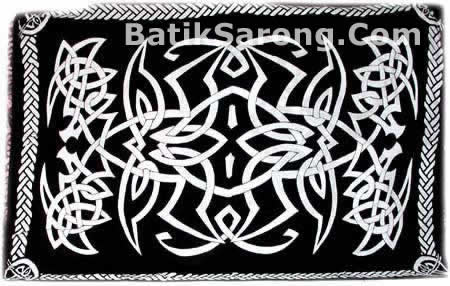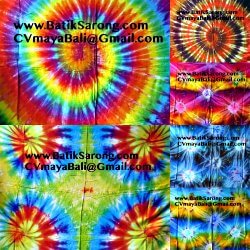
The History of Batik
Evidence of early examples of batik have been found
in the Far East, Middle East, Central Asia and India from over 2000 years ago.
It is conceivable that these areas developed independently, without the influence
from trade or cultural exchanges. However, it is more likely that the craft
spread from Asia to the islands of the Malay Archipelago and west to the Middle
East through the caravan route.
Batik was practised in China as early as the Sui Dynasty (AD 581-618). These
were silk batiks and these have also been discovered in Nara, Japan in the form
of screens and ascribed to the Nara period (AD 710-794). It is probable that
these were made by Chinese artists. They are decorated with trees, animals,
flute players, hunting scenes and stylised mountains. No evidence of very old
cotton batiks have been found in India but frescoes in the Ajunta caves depict
head wraps and garments which could well have been batiks.
In Java and Bali temple ruins contain figures whose garments are patterned in
a manner suggestive of batik. By 1677 there is evidence of a considerable export
trade, mostly on silk from China to Java, Sumatra, Persia and Hindustan. In
Egypt linen and occasionally woollen fabrics have been excavated bearing white
patterns on a blue ground and are the oldest known and date from the 5th century
A.D. They were made in Egypt, possibly Syria. In central Africa resist dyeing
using cassava and rice paste has existed for centuries in the Yoruba tribe of
Southern Nigeria and Senegal.
See Beach Pareos Made In Indonesia
Indonesia, most particularly the island of Java,
is the area where batik has reached the greatest peak of accomplishment. The
Dutch brought Indonesian craftsmen to teach the craft to Dutch warders in several
factories in Holland from 1835. The Swiss produced imitation batik in the early
1940s. A wax block form of printing was developed in Java using a cap. By the
early 1900s the Germans had developed mass production of batiks. There are many
examples of this form of batik as well as hand-produced work in many parts of
the world today. Computerisation of batik techniques is a very recent development.
There is nowhere in the world where the art of batik has been developed to the
highest standards as in the island of Java in Indonesia. All the raw materials
for the process are readily available - cotton and beeswax and many plants from
which the dyes are made.
It is not known when the batik was first made but the traditional skills were
particularly well developed over hundreds of years in Central Java around Yogyakarta
and Solo under the patronage of the Sultan and his court. Designs were copies
and in some cases the cloths could only be used by certain people or on certain
occasions. The royal families had their own proscribed designs. On the coast
designs were developed differently, influenced by settlers from China, the Dutch
colonists and traders from India and Arabia.
Two methods of applying wax are used.
>>>The cloth is hung over the frame and the design is drawn on with
a canting, a small copper cupped spout which is attached to a bamboo or wooden
handle. The canting is dipped into a pot of hot wax and then allowed to flow
through the spout on to the fabric. On thicker fabrics the waxing is carried
out on both sides. This process is carried out by the women
>>>The cloth is stretched on to long tables and a cap or copper stamping
tool is used. This is dipped into a pan of hot wax and pressed on to the fabric.
This enables the design to be repeated many times and is usually done on both
sides of the fabric by men. This is a much faster method of wax application.
The traditional dyes used are deep indigo blues and soga browns and these are
still the characteristic colours for work in central Java. Towards the end of
the 19th century chemical dyes were introduced in the coastal regions and as
a result of this the colours are usually brilliant and more varied. The final
hand made lengths of cloth, known as Tulis, may take several months to produce
and are consequently very expensive. Everywhere in Indonesia people still wear
clothing made from batik cloth and the tourist industry has opened up a new
market for cheap batik clothing and pictures.
Reproduced from The Art of Batik, written and published by The Batik Guild, 1999
Browse Our Batik Beach Wraps Catalog by category:
Handcrafted Jewelry & Fashion Accessories from Bali Indonesia:
Handmade Footwear Made in Indonesia:
Go Back to Batik Sarongs Home Page
Natural Footwears (Sandals Slippers Made in Indonesia)
Tie Dye Pareo Made in Indonesia . Handmade tie-dye sarongs and pareos featuring bright, vibrant colors. Crafted by skilled traditional batik artisans in Bali and Java, Indonesia. Ideal for casual beach and poolside wear or as stylish travel attire. Perfect for festivals and boho fashion, as well as bohemian and retro 70s styles. Order now in wholesale bulk quantities directly from our sarong factory in Indonesia. We ship worldwide and have been trusted since 2001, with decades of experience in producing and shipping orders for overseas buyers. Send us your order via email or chat with us on WhatsApp. See the photo for our contact details.

Bali Handicrafts Company | Bali Beads Necklaces | Natural Photo Album | Bali Wood Carvings | Clothing from Bali